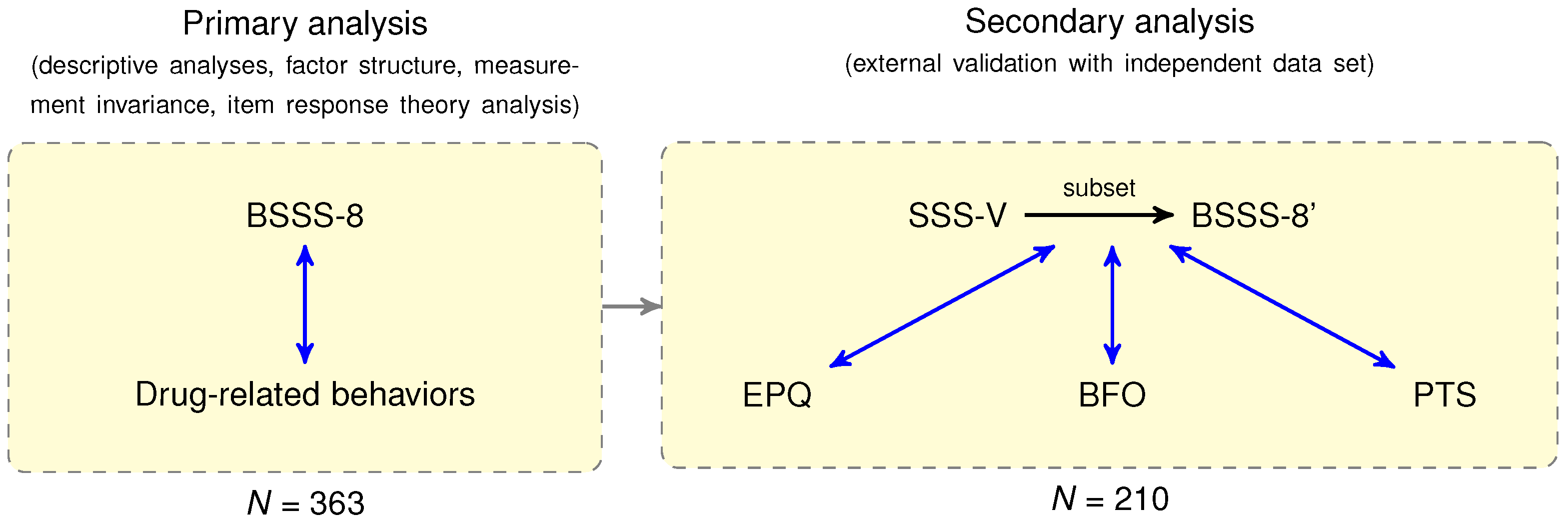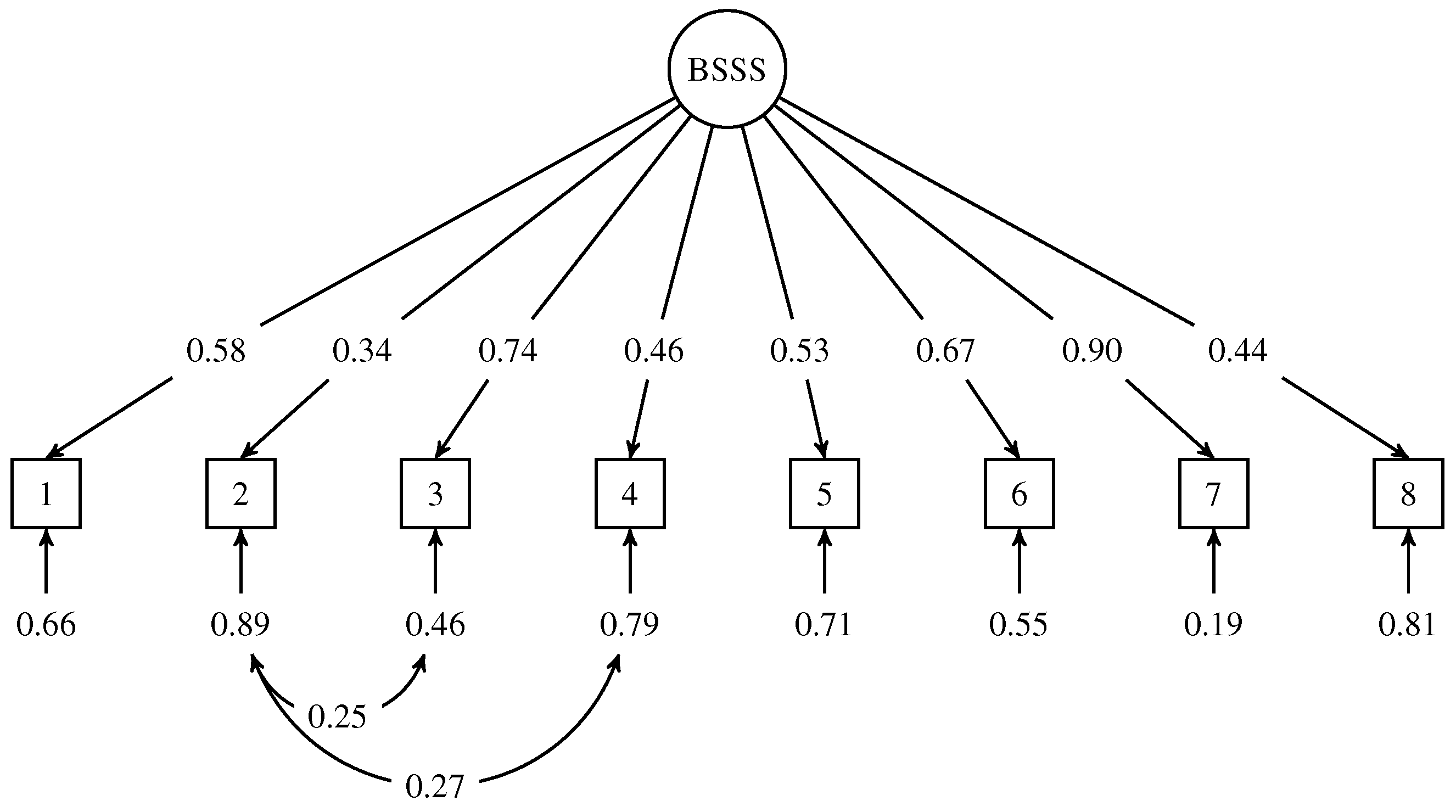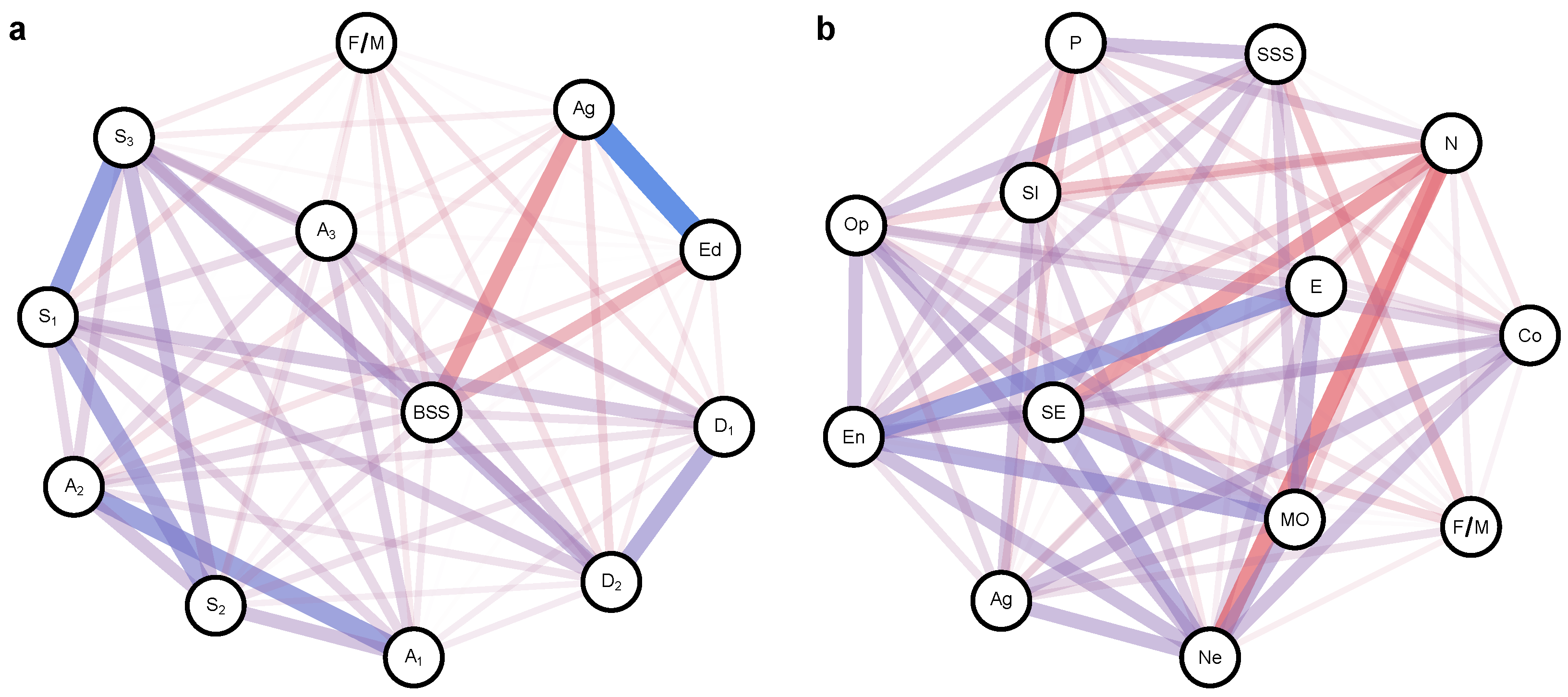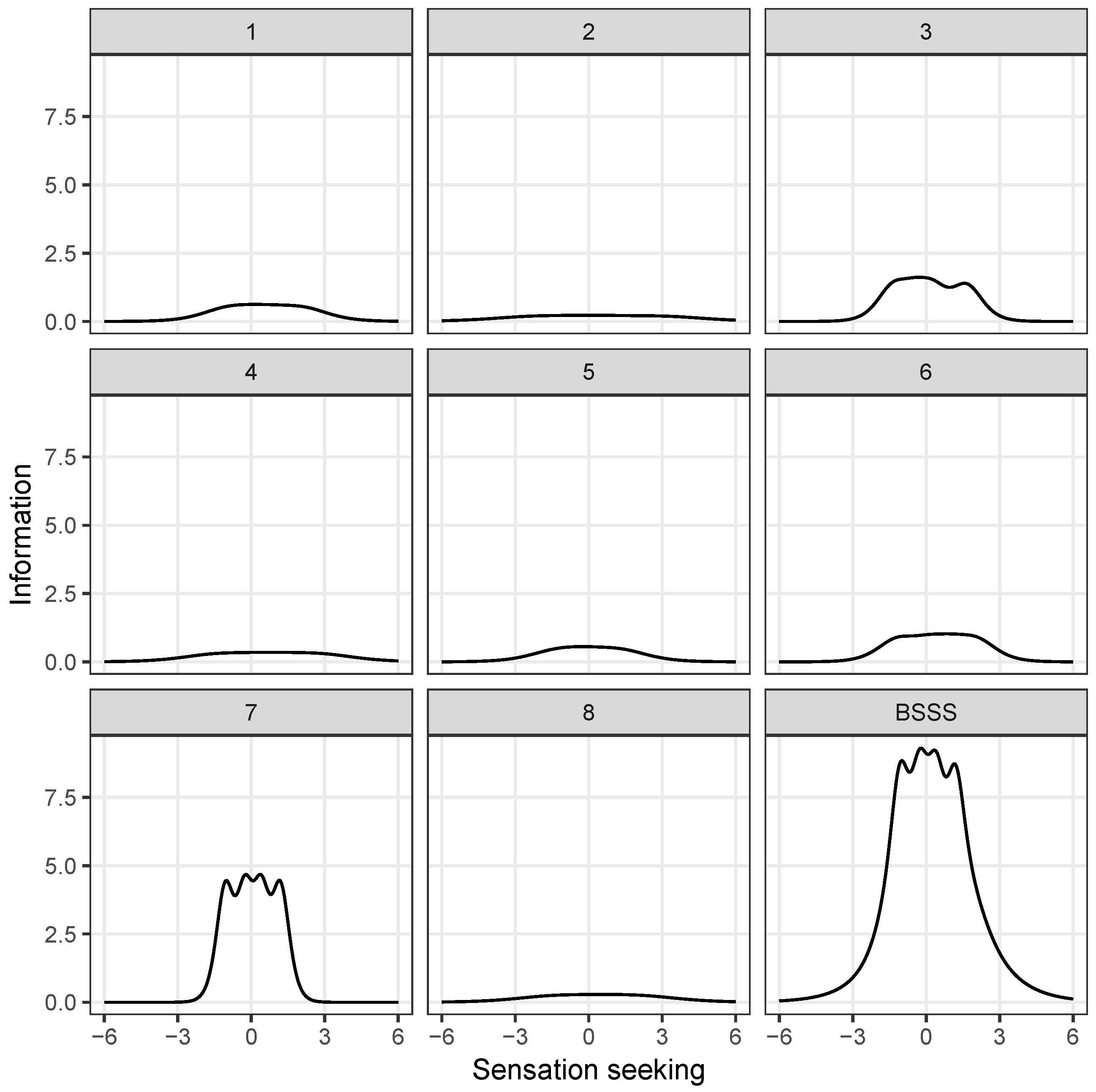1. Introduction
Sensation seeking (SS from now on) has received considerable attention in the academic literature and has been recognized as one of the most studied personality traits in both healthy and psychiatric populations [
1,
2,
3]. By formal definition, SS is a psychobiological personality trait that can be described as the “seeking of varied, novel, complex, and intense situations and experiences, and the willingness to take physical, social, and financial risks for the sake of such experience” ([
2], p. 27). Individuals with high SS may seek more intense rewards, even if they are harmful or addictive, and are consequently inclined to engage in risky behaviors, such as gambling, experimenting with drugs, or speeding [
4]. Therefore, reliable and valid measurements of SS are crucial for preventing unhealthy behavioral patterns.
Systematic research on SS was initiated in the mid-20th century through military experiments on sensory deprivation [
3]. In the late 1960s, Zuckerman, a pioneer in SS, presented the first conceptual framework to describe SS behavior [
1,
2,
3]. Zuckerman’s approach draws on the optimal level of arousal theory to explain individual differences in SS [
1]. People have a preferred stimulus level, where some individuals seek intense arousal while others prefer low arousal. However, the research community did not fully support Zuckerman’s claims. Two decades later, he replaced the concept of optimal arousal with the optimal level of catecholaminergic activity in the limbic system [
3]. This suggests that individuals have a specific level of catecholamine activity at which they are most comfortable and satisfied, and deviations from this level may drive their SS behavior. Empirical evidence indicates a high degree of trait heritability; however, the genetic background is not fully understood [
5].
From a nomological perspective, SS is very similar to Eysenck’s psychoticism in terms of both impulsiveness and the propensity for new stimuli [
6]. A review of the empirical results also shows associations with Extroversion, Openness to Experiences, and the dark triad traits (i.e., Machiavellianism, narcissism, and psychopathy) [
7,
8]. The literature has extensively examined the link between sensation seeking and risk behavior, including alcohol consumption [
9], cigarette smoking [
10], drug abuse [
11], psychoactive substance use [
12], risky sexual behavior [
13], pathological gambling [
14], extreme sports [
15], aberrant driving behavior [
16], and even delinquent behavior [
17].
In psychometrics, SS is typically assessed using self-report questionnaires. Several instruments have been developed to measure this trait, either with complex global scales or specific questionnaires. For example, the Zuckerman–Kuhlman–Aluja Personality Questionnaire (ZKA-PQ) embeds a separate SS factor into a 200-item personality inventory [
18]. On the other hand, Arnett [
19] combined two dimensions, intensity and novelty, into a unified 20-item questionnaire, the Arnett Inventory of Sensation Seeking (AISS), to measure the construct of SS. The ZKA-PQ is too comprehensive for use in SS assessments, whereas the AISS has been criticized for its unacceptable reliability [
20]. However, the Zuckerman’s Sensation Seeking Scale, Form V (SSS-V), has become a widely accepted standard for measuring sensation seeking [
21]. The scale includes 40 forced-choice items and consistently reveals a four-dimensional structure [
2]: Thrill and Adventure Seeking (TAS), Experience Seeking (ES), Disinhibition (Dis), and Boredom Susceptibility (BS). Example items are “I would like to try parachute jumping” (TAS) and “I can’t stand watching a movie that I’ve seen before” (BS). Despite its widespread use, the SSS-V has faced criticism. Researchers have complained about the length, colloquial language (i.e., many items are defined using an obsolete language [
19,
22]), and ipsative scoring (i.e., the forced-choice questionnaire format violates the assumption of item independence and makes the data unsuitable for standard factor analysis [
23]) of the instrument. In addition, modern psychometry promotes the use of “super-short” personality measures, which are particularly useful in research settings with large sample sizes, online surveys, and studies investigating multiple personality constructs [
24]. By using short questionnaire forms, we can overcome the problem of low response rates [
25] or time constraints [
26].
Several other scales have been developed to overcome the shortcomings of the SSS-V. Based on a subset of 10 items from Zuckerman’s SSS-IV questionnaire, Madsen et al. [
27] made the first attempt and developed the Short Sensation-Seeking Scale. Psychometric validation of the scale was promising (i.e., high retest reliability and significant correlations with drug- and gender-related behaviors), but the research community did not adopt it. Hoyle et al. [
28] later developed the Brief Sensation-Seeking Scale (BSSS-8) based on a subset of eight items from the SSS-V. The use of Likert-type items allowed the authors to solve issues related to ipsative scoring. The scale exhibited excellent item characteristics and high reliability across gender, age, and ethnicity. The BSSS-8 score has been shown to be a reliable predictor of several risky activities, including excessive alcohol consumption, smoking, and illicit drug use [
9,
28,
29,
30]. The BSSS-8 retains Zuckerman’s conceptualization of SS, structured around four dimensions with two items per dimension. The BSSS-8 has received substantial recognition from the research community. At the time of this writing, Hoyle et al.’s [
28] work has been cited more than 1500 times.
The findings of studies that have assessed the metric properties of the BSSS-8 have been ambiguous regarding factor structure, with no agreement on the number of factors. Stephenson et al. [
30] found a second-order unidimensional factor solution for English-speaking Latinos and a four-factor structure for Spanish-speaking Latinos. Chen et al. [
31] adapted the BSSS-8 for Chinese speakers and found a four-factor structure. The high correlations between sensation seeking and various risk-taking behaviors provided evidence of concurrent validity. Primi et al. [
32] adapted and validated the Italian version of the BSSS-8 for high school students. The authors confirmed a single-factor latent structure that was invariant across demographic groups, including age and gender. Criterion validity was confirmed to be significantly related to gambling behavior. Next, Ref. [
33] adapted and validated the BSSS-8 with a large group of Spanish-speaking Peruvian adolescents. The authors demonstrated a unidimensional latent structure, and concurrent validity was assessed using alcohol, tobacco, and marijuana use. Pechorro et al. [
34] conducted a validation study among adolescents at risk for criminal behavior in Portugal. The authors demonstrated that the single-factor structure of the BSSS-8 is an appropriate solution. They found associations between criminal tendencies and the dark triad traits. Martín-Fernández et al. [
35] also showed the unidimensional structure of the BSSS-8 in young Spanish adults. Merino-Soto et al. [
36] recently demonstrated similar findings. In summary, these studies highlight the need for further research on the dimensionality of the BSSS-8.
To date, only non-validated versions of the SSS-IV and SSS-V scales have been used to measure SS in the Slovenian population (e.g., [
37]). In Slovenia, SS has not been systematically studied, and no instruments have been adapted or developed to measure the SS concept. The main goal of this study is to develop a Slovenian version of the BSSS-8 scale. Specifically, three objectives are pursued: (i) to translate the original English version of the BSSS-8 scale into Slovenian; (ii) to examine its metric properties, including factor structure, reliability, and metric invariance; and (iii) to examine the construct validity of the BSSS-8 scale through a nomological network, incorporating other personality and temperament variables.
4. Discussion
Recently, the BSSS-8 was translated and adapted to various linguistic contexts. The main objective of this work was to provide a Slovenian version of the BSSS-8, accompanied by a comprehensive psychometric validation. The results showed that the Slovenian version of the BSSS-8 has good psychometric properties, including high reliability, good structural validity, and expected patterns of differences between genders and age groups. The CFA yielded a unidimensional factor structure. In addition, the single-factor solution proved to be invariant for both female and male participants. Nevertheless, it is imperative to acknowledge that further studies are required to determine the extent to which our findings can be generalized across genders, age cohorts, and educational levels.
A large amount of research has been conducted on sensation seeking SS over the last 40 years [
4]. Various authors agree that SS is a psychological construct encompassing multiple dimensions. While the BSSS-8 was conceptualized based on Zuckerman’s four subfactors of SS, most researchers hypothesized that the scale primarily measures a single dimension of SS [
28,
33,
34,
70,
71]. Our findings provide support for the unidimensional nature of the BSSS-8 and are in line with a comparable validation study of the BSSS in Spanish adolescents and young adults [
35]. Considering the relatively small number of items, we believe that the unidimensional structure of BSSS-8 is more precise and parsimonious than the four-dimensional alternative. The results of the study also showed that the one-dimensional factor solution worked well for both male and female participants, whereas this was not the case with the four factors [
72].
The translated version of the BSSS-8 showed good reliability, higher than that reported in previous studies [
28,
32]. In our study, the Cronbach’s
was above 0.80, which is the recommended value for acceptable reliability [
73]. In addition to adequate reliability, the scale also showed good validity. Regarding construct validity, men scored significantly higher than women did. This finding is consistent with those of previous studies. For example, Zuckerman [
3] reported that men scored higher than women on all subscales of the SSS-V, with the exception of the ES subscale. Cross et al. [
74] conducted a comprehensive meta-analysis of gender differences in SS and showed that differences between females and males in SSS-V scores were stable over time, mainly due to the factors Dis and BS. In addition to gender, age was also significantly related to the BSSS-8 score in our study; younger participants reported significantly higher scores on SS than older participants. Zuckerman [
2] postulated that SS increases in early childhood, peaks in adolescence, and decreases thereafter. Several authors have confirmed this assumption. For example, Steinberg et al. [
75] and Khurana et al. [
76] demonstrated that age differences in SS have a curvilinear shape, with a peak at approximately 15 years. In terms of concurrent validity, the BSSS-8 score was positively correlated with drug-related behaviors. This finding is consistent with the results of similar studies. A review of empirical evidence indicates that SS has strong predictive power for substance abuse and addiction [
77]. Therefore, the BSSS-8 is a useful instrument for screening individuals whose high SS scores may correlate with (illegal) drug abuse.
Validation of the instrument for measurement invariance is an essential principle of modern psychometrics. We confirmed that the translated and adapted Slovenian version of the BSSS-8 is sex invariant. In less formal terms, this means that both women and men have similar conceptualizations of SS (configural invariance) and respond similarly to questionnaire items (weak invariance). In addition, it is possible to compare mean BSSS-8 total scores between sexes (strong invariance), and we can also compare raw BSSS-8 scores between women and men (strict invariance). In this study, measurement invariance across age groups and educational levels could not be confirmed. Comparisons of latent scores across age groups may be significantly biased, and differences in observed scores may not reflect true age-related differences in the SS. However, further studies with larger and more balanced groups (in terms of the desired grouping variables) are required.
We examined the intersubject variability of the included variables using a nonlinear multivariate analysis technique known as t-SNE. The t-SNE algorithm is a machine learning algorithm that facilitates the representation of a complex, high-dimensional dataset in a low-dimensional space. Using t-SNE, we were able to discriminate between the three homogeneous groups of participants. The algorithm clearly classified all “critical” participants with a high level of SS and a high probability of risky behavior into a single group. We attempted to replicate the t-SNE results using principal component analysis and multidimensional scaling but without success. In our opinion, t-SNE should receive more attention in current health research, including psychology.
This study provides further evidence for the validity of the BSSS-8 scale by comparing actual results with independent raw data from our previous study, which utilized the SSS-V scale in conjunction with two personality measures and a temperament survey. We selected eight BSSS items from a pool of 40 SSS-V items and computed the total score. The SS score based on the subset of SSS-V items showed the expected pattern of correlations with personality traits and temperament characteristics [
7]. Specifically, our results demonstrated positive correlations between the SS score and Openness to Experience, Extroversion, and Psychoticism [
78], providing additional support for the validity of the BSSS-8.
The major strengths of this study are the assessment of measurement invariance and the implementation of item response theory analysis. The translated scale will be particularly valuable in epidemiological research or as part of a larger battery of psychometric measures. To date, the Slovenian research community has used only outdated SSS-IV or inadequately adapted SSS-V scales. Last but not least, the translated scale will expand the existing psychological measurement tools used in research on factors contributing to risky behavior among Slovenian adolescents [
79].
Along with the strengths described above, we acknowledge four limitations of the present study that should be considered in future research. First, and most importantly, a convenience sampling strategy resulted in a low proportion of males and a low proportion of older participants, which may have biased our conclusions. In the latter case, we discretized the age variable to distribute participants more evenly between the two groups. Furthermore, we repeated the standard procedure for measurement invariance using the Monte Carlo simulation to address the problem with imbalanced group sizes as proposed by Yoon and Lai [
61] (see
Section 2.4 and
Section 3.3). The convenience sampling strategy is quick and cost effective but obviously results in sampling bias, limiting our ability to fully generalize the presented results. For example, a recent validation of the Dutch BSSS-8 scale reported an even higher discrepancy between the proportion of females and males [
80]. Further research is required to thoroughly investigate the psychometric properties of the translated scale, using a more representative sample. Second, a longitudinal research design is required to estimate the metric characteristics of the scale over time. Validity would have been enhanced by comparing the BSSS-8 with other personality constructs (e.g., impulsiveness) using appropriate instruments. Third, future studies should systematically investigate the potential cultural biases that may arise in the linguistic adaptation process to ensure that the participants correctly understand the translated items. Finally, we did not control for the level of social desirability, although indicators of risk behaviors (even when a study is anonymous) may correlate with social desirability [
81]. Despite these limitations, at the time of writing, the Slovenian version of the BSSS-8 is the most adequate instrument for assessing SS in Slovenia.
Knowledge of the SS construct is still incomplete. A thorough exploration of the biological mechanisms and societal factors underlying SS has not been conducted. We believe that functional brain imaging, molecular genetics, and modern statistical methods (e.g., complex network analysis) will provide further evidence for a better understanding of SS. We hope that our study will provide valuable insights in this direction.













